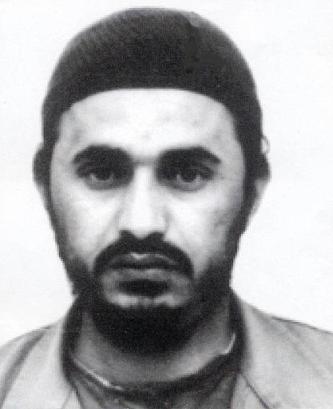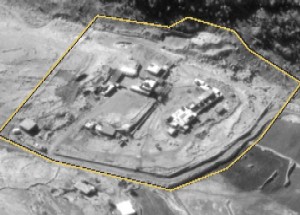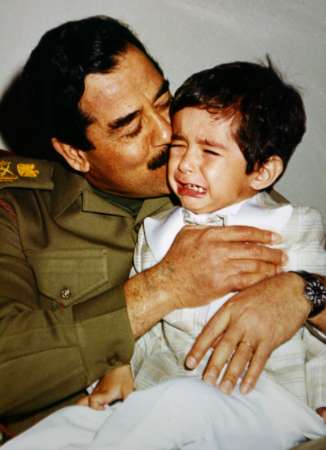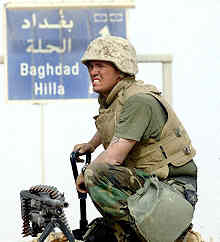|
Abu Musab al-Zarqawi The first time most Americans heard the name of terrorist Abu Musab al-Zarqawi was when Colin Powell stood before the United Nations to make his case for invading Iraq.
The first time most Americans heard the name of terrorist Abu Musab al-Zarqawi was when Colin Powell stood before the United Nations to make his case for invading Iraq. While much of Powell's statement turned out to be fictional, Zarqawi is unfortunately quite real. As is often the case with the terrorist underground, we know a lot about Zarqawi and yet not nearly enough. For instance, such basic details as his real name and the country of his birth remain obscure. He is believed to have been born in Jordan, possibly of Palestinian descent. His aliases include Fadel Nazzal al-Khalayleh, Fadil al-Khalaylah, Ahmad Fadil Al-Khalailah and just Habib. One of the Fad'l variations is probably in the neighborhood of his birth name. He may or may not be missing a leg, which is a much more important issue than you might think. Zarqawi hails from the town of Zarqa, Jordan, from whence his best-known alias is derived. He's thought to be a high school dropout. Zarqawi went to Afghanistan to fight the Soviets in the late 1980s, which has been the ruin of many a poor boy. In Afghanistan, Zarqawi plugged into the al Qaeda terrorist network, at the time fighting the Soviet Union with the support of the CIA. In Afghanistan and Pakistan, Qaeda ran training camps where angry young men met other angry young men and formed lifelong friendships. One of the people Zarqawi is known to have met in the training camps was a young Pakistani explosives expert named Abdel Basit, who would later be known to the world as Ramzi Yousef. Other major terrorists were working in the camps at that time, including Khalid Shaikh Mohammed and the big cheese, Osama bin Laden, who was more or less running the operation. Jordan, like other Middle Eastern states, recognized the threat posed by Afghan mujahideen much earlier than the West. Jordan and Egypt, among other countries, responded to that perceived threat by arbitrarily imprisoning the mujahideen, usually without charge and often under brutal conditions. Not surprisingly, this treatment only increased their anger and radicalism. Right or wrong, when Zarqawi returned to Jordan in the early 1990s, he was jailed and spent seven years in jail. When he emerged, he was a full-blown radical who (according to Jordanian authorities) immediately began plotting attacks on U.S. and Israeli tourists in Jordan. He fled to Pakistan soon after leaving prison. From the start, intelligence officials believe, Zarqawi only worked with bin Laden to further his goal of setting up his own terrorist shop.
The Z-man found shelter in Iran for a while, but Colin Powell didn't care. According to U.S. intelligence, Zarqawi traveled to Iraq in early 2002, and allegedly began associating with Ansar al-Islam, an impoverished group of 600 to 800 Iraqi Kurds whose stated goal was to secede from Saddam's Iraq so that its tiny, ethnically exclusive clan could go hide out in the mountains. Of course, there's room for a different interpretation of Ansar's role. For instance, if you're Colin Powell and you're desperate to sell an Iraq invasion to the international community, you could argue that Ansar was a "sinister nexus between Iraq and the al Qaeda terrorist network, a nexus that combines classic terrorist organizations and modern methods of murder." The American Heritage Dictionary defines a nexus as "A means of connection; a link or tie." Whatever else Ansar was, it certainly wasn't a nexus. Geographically stuck between Iran, Iraq and the mainstream Kurds, Ansar was not an effective force in the region. al Qaeda briefly cultivated a relationship with the group, because of its strategic location relative to Afghanistan. When bin Laden and his crew were forced to retreat to the Pakistan-Afghanistan border, al Qaeda's interest in Asnar faded.
As it turns out, the report of medical treatment wasn't even credible to begin with. According to U.S. intelligence, Zarqawi had a leg amputated in Baghdad. Except that most sources now believe Zarqawi is equipped with two working legs. As Newsweek colorfully put in in early 2004, "The stark fact is that we don’t even know for sure how many legs Abu Mussab al-Zarqawi has, let alone whether the Jordanian terrorist, purportedly tied to al Qaeda, is really behind the latest outrages in Iraq." The remainder of Powell's claims about Iraq were less than airtight, as we all know by now. There is virtually no evidence to support claims that al Qaeda and Iraq were working together. bin Laden openly advocated the overthrow of Hussein before the U.S. decided to invade. There may well have been al Qaeda operatives in Baghdad, but there were also al Qaeda operatives in New York, Madrid, Cairo, Fort Lauderdale and Norman, Oklahoma. Although they've stopped repeating the above claims, the U.S. government has not formally retracted its claims about Zarqawi, despite extensive media reports casting doubt on most of Powell's speech. But that doesn't mean the Z-Man's usefulness as a propaganda tool has ended. Far from it. The U.S. government has significantly upped the ante on Zarqawi's status since toppling Saddam Hussein. According to the Pentagon, Zarqawi has been a lightning rod for Iraq's resistance to the U.S. occupation force. U.S. intelligence sources speaking on and off the record now blame Zarqawi for virtually every terrorist attack seen in the last year, including the 3/11 Madrid train bombing and bomb attacks on Shi'ite Muslims in Iraq. In February 2004, the U.S. claimed it had intercepted a letter from Zarqawi to al Qaeda, outlining his strategy in Iraq and asking for reinforcements. In addition to "proving" once and for all that Zarqawi was an al Qaeda evildoer, the letter further explained that Zarqawi was responsible for bombing the Shi'ites (most al Qaeda terrorists are Sunni Muslims):
We are striving urgently and racing against time to create companies of mujahidin that will repair to secure places and strive to reconnoiter the country, hunting the enemy –- Americans, police, and soldiers -- on the roads and lanes. We are continuing to train and multiply them. As for the Shi`a, we will hurt them, God willing, through martyrdom operations and car bombs.Even MORE convenient than the al Qaeda link was the fact that the letter seemed like a sure bet to drive a wedge between the Shi'ites and Sunnis. If Sunni extremists were deliberately targeting Shi'ites, then obviously the two groups couldn't possibly join forces against the U.S. occupation and its hand-picked provisional government. The letter didn't stop Sunnis and Shi'ites from doing just that, however. Unfortunately for our intrepid protagonists, the letter was quickly judged to be a forgery by just about anyone whose opinion mattered. Even Western journalists openly scoffed at the letter's authenticity, let alone the conspiracy-obsessed Arab world, which went to town over the incident. The U.S. didn't help matters by flatly refusing to discuss how it got its hands on the letter. "The important thing is that we have this document in our hands," explained Brig. Gen. Mark Kimmitt in February. "How it was found is not as important as the fact that we have it." Given the U.S. intelligence record to date, that's a pretty iffy proposition. By now, you may be wondering what a reasonable person can actually claim to know about Abu Musab al-Zarqawi, and it's a good question. The piles of misinformation are so deep that it's nearly impossible to divine the truth. Shortly after the 3/11 bombing of a Madrid commuter train, pundits began speculating on a Zarqawi link, based on comments by French terrorism investigator Jean-Charles Brisard. The most compelling reason to think this might be true is that it didn't come from the U.S. government.
In recent media interviews with captured Ansar al-Islam operatives, the terrorists said they never laid eyes on Zarqawi (the interviewees provided other verifiable information on Ansar activities). Ansar itself has been more or less made obsolete by the U.S. invasion, which spurred an influx of thousands of foreign fighters into Iraq (some al Qaeda-linked, but others not). In early 2004, some Iraqi insurgents claimed in a leaflet that Zarqawi had been killed. Not too many people believe this to be true. A tape released in April 2004 appeared to be from the Z-Man himself. According to the tape, Zarqawi took credit for several bomb attacks against U.S. and coalition forces. He pointedly did not take credit for the attacks on Shi'ites, but he did castigate the Shi'ites as "idolators." He called on Iraqis to "burn the earth under the occupiers' feet." After the tape was released, the U.S. increased its reward for his capture to $25 million -- on a par with bin Laden and Ayman Al-Zawahiri before their recent increases to $50 million. In May, Zarqawi made himself into a star of the Internet with a homemade snuff video that really got people talking. The video, released with the catchy title "Sheikh Abu Musab al-Zarqawi slaughters an American infidel with his own hands" delivered pretty much as advertised, ending with a scene of Zarqawi brandishing the decapitated head of an American civilian named Nicholas Berg. About the only evil act missing from the long list of charges against Zarqawi had been any use of the chemical weapons which are his alleged specialty. It was especially odd since (from what we hear) Iraq was just chock-full of evil chemicals waiting for such attacks. However, that oversight was rectified in late April 2004, when Jordanian officials named Zarqawi the mastermind of a foiled plot to kill 80,000 people with a chemical attack. (Bear in mind that this estimate may be a trifle high. Ramzi Yousef planned to kill 250,000 people in his 1993 attack on the World Trade Center. The actual death count was six.) And just how many legs does Zarqawi have anyway? We're going to have to get back to you on that, but we can definitively state the answer is no more than three and no less than zero. Probably. Update: Despite many prior rumors of Zarqawi's death, it appears that he really is now dead, since two 500-lb bombs were dropped on his safehouse on June 7, 2006. Zarqawi may have precipitated his demise by appearing in a propaganda video made weeks earlier. More on this as it develops... |
 Zarqawi's original plan was to overthrow the government of Jordan, but when he was smoked out of the country and sentenced to death in absentia, he went traveling, first to Europe then back to the Middle East and South Asia. Zarqawi allegedly ran a semi-independent shop on the border between Afghanistan and Iran, teaching his students how to use poisons and chemical weapons in terrorist attacks. After the U.S. invasion of Afghanistan, Zarqawi had to make tracks. According to Colin Powell, that's when the trouble really began.
Zarqawi's original plan was to overthrow the government of Jordan, but when he was smoked out of the country and sentenced to death in absentia, he went traveling, first to Europe then back to the Middle East and South Asia. Zarqawi allegedly ran a semi-independent shop on the border between Afghanistan and Iran, teaching his students how to use poisons and chemical weapons in terrorist attacks. After the U.S. invasion of Afghanistan, Zarqawi had to make tracks. According to Colin Powell, that's when the trouble really began.  According to the U.S. pre-Iraq party line, Zarqawi used his "base" in Iraq to stage bombings and terrorist attacks in Turkey and Morocco. Powell told the U.N. that Zarqawi received medical treatment during a stay in Baghdad in May 2002. This was supposed to illustrate Saddam's alliance with al Qaeda. (No one ever talks about the fact that Ramzi Yousef received medical treatment from a hospital in New Jersey after a minor car accident in 1993. Did
According to the U.S. pre-Iraq party line, Zarqawi used his "base" in Iraq to stage bombings and terrorist attacks in Turkey and Morocco. Powell told the U.N. that Zarqawi received medical treatment during a stay in Baghdad in May 2002. This was supposed to illustrate Saddam's alliance with al Qaeda. (No one ever talks about the fact that Ramzi Yousef received medical treatment from a hospital in New Jersey after a minor car accident in 1993. Did  Despite all the laborious U.S. efforts to prove a link, most independent experts believe Zarqawi is not operating on behalf of al Qaeda, a conclusion which the U.S. military reluctantly conceded in early 2004.
Despite all the laborious U.S. efforts to prove a link, most independent experts believe Zarqawi is not operating on behalf of al Qaeda, a conclusion which the U.S. military reluctantly conceded in early 2004.